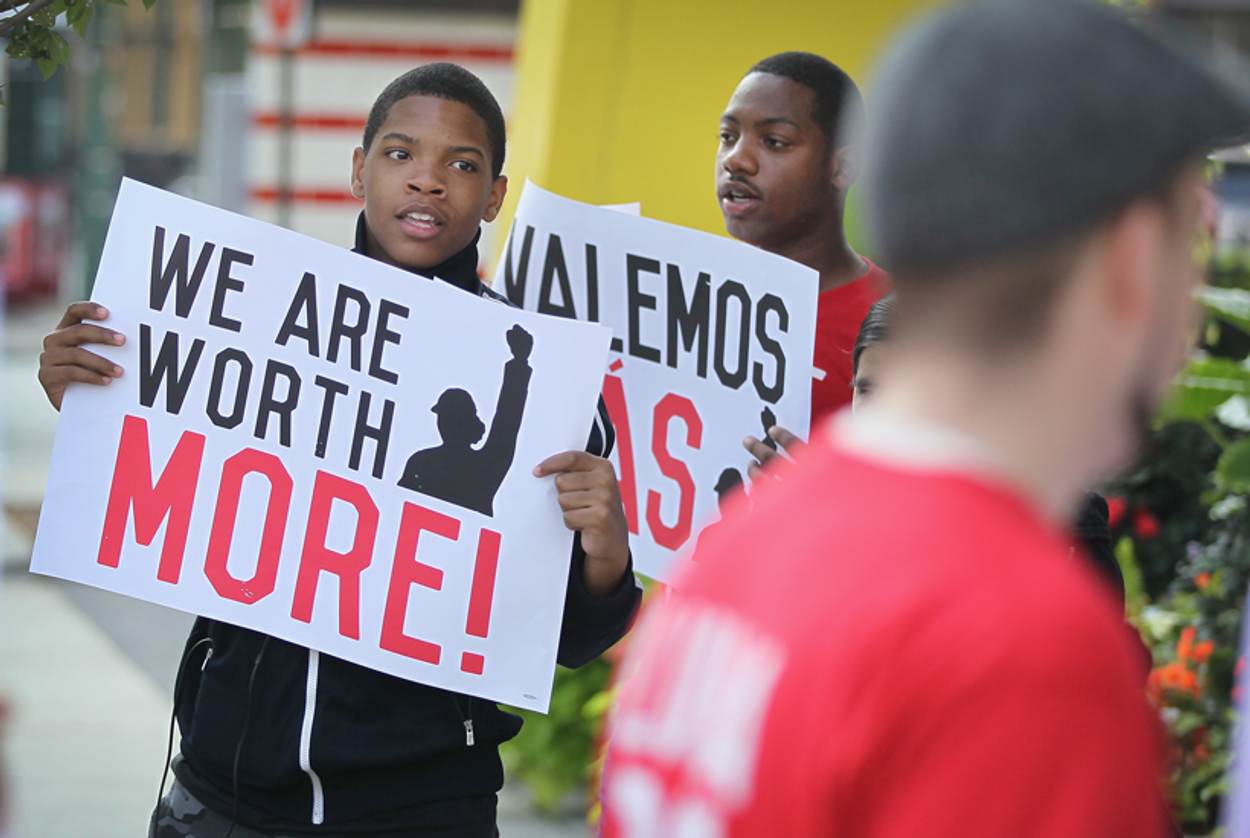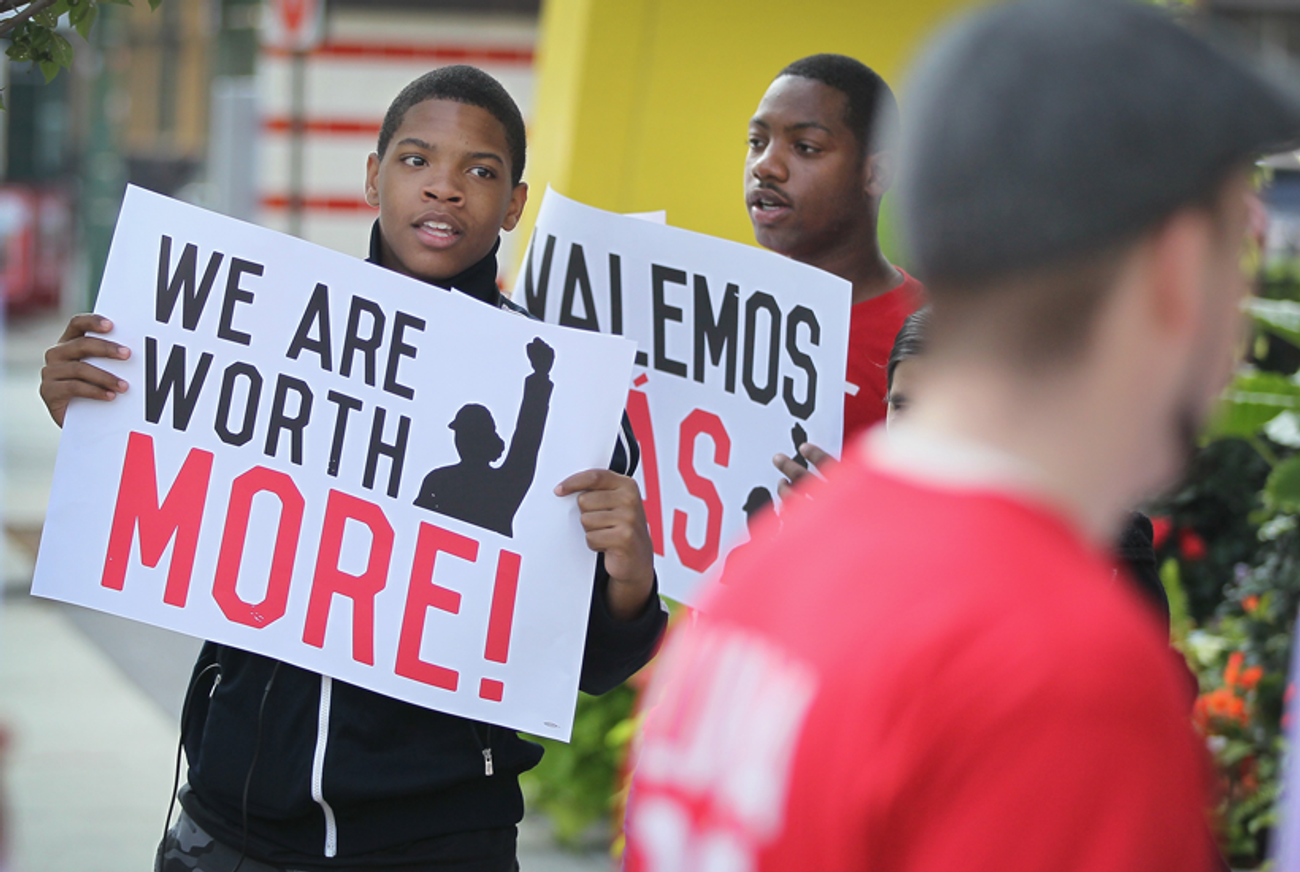Long Before Politicians Backed Wage Increases, Talmudic Sages Argued the Cause
On election day, voters will weigh in on minimum-wage hikes. It’s a fight that reaches back to the Talmud.




Throughout 2014, few issues have occupied more space in the public square than income inequality and the concentration of wealth. When else has a 700-page book about the inexorable concentration of wealth under modern capitalism—by a French economist, no less—made the New York Times best-seller list? The large and increasing U.S. income gap jockeys for space in political races throughout the country, but the clearest battle lines are drawn in state and local initiatives to raise the minimum wage above the federally mandated level of $7.25/hour. Many of those initiatives will be put to the test on election day.
That’s when voters in Alaska, Arkansas, Nebraska, and South Dakota will decide on modest minimum wage increases. In California, voters in Oakland and San Francisco will decide whether to increase the minimum to $12.25 and $13 respectively.
Organized Jewish support of such increases has made a difference in several successful recent campaigns, including Minnesota, Massachusetts, Washington, D.C., and various jurisdictions in Maryland. Minnesota’s Union Advocate noted that the statewide Jewish Community Action organization “proved critical in generating support in areas where unions don’t have a lot of membership.” Vic Rosenthal, the JCA director, notes that the group was particularly effective in efforts to lobby a pivotal Jewish legislator: “Part of the discussion was why this was an issue that Jews should be concerned about. We could argue the case in textual terms. It was also about the history of the Jewish community and its relationship with labor unions.” The increase in Minnesota from the federal minimum of $9.50 in 2016 includes a future cost of living index, a key but difficult-to-win demand of many local proposals.
Even where Jewish advocacy is more individual than organized, there is often a distinctly Jewish voice in the crowd. In SeaTac, a working-class suburb of Seattle, the Airport Workers Campaign (AWC) successfully promoted a city referendum in late 2013 that raised airport wages for permanent and subcontract employees alike to $15 plus paid sick days. As part of the organizing effort, Jonathan Rosenblum, AWC director and an active member of Seattle’s Kadima Congregation, addressed churches and gatherings of Muslim workers. Referencing Nachshon, whom midrash credits with braving the first steps across the Red Sea, Rosenblum told them: “Faith alone is not going to deliver justice; you also need to act.” And in San Diego, where a City Council-passed increase has been successfully delayed by a business coalition, Rabbi Laurie Coskey leads a key coalition partner, the Interfaith Center for Worker Justice: “People understand that we are going to change the framework of the conversation from the marketplace to one of human values of creation in the divine image, and dignity and respect.” If sanctioned by the 2016 referendum, the San Diego initiative will raise the minimum wage to $11.50 by 2017 and then index it, affecting 172,000 workers.
Earlier this year a statewide Massachusetts coalition to raise the minimum wage included two Jewish advocacy groups—the Jewish Alliance for Law and Social Action and the Jewish Labor Committee. About 50 representatives from 15 synagogues collected 9,000 signatures that were submitted to the state legislature as part of a successful effort to increase the state minimum. (The statewide coalition collection 360,000 signatures in all.) Synagogue outreach efforts met no organized opposition, said JALSA Director Sheila Dechter, but neither was support always easy to come by: “Some of the Conservative synagogues worried about the impact within the synagogue. They focused on shalom bayit (peace in the house),” among congregants with opposing views on wage increases. Dechter continued, “That can sometimes become an excuse for not dealing with the substance of the issue.” But New England Jewish Labor Committee Director Marya Axner assesses a general level of support: “It’s written so many times—the source texts are really not kidding,” she commented, “This issue makes sense to people, even Jews who are not sympathetic to the labor movement.”
Perhaps the most advanced level of organized Jewish involvement has been a trifecta of campaigns involving Jews United for Justice, based in Washington, D.C. Through the end of the statewide effort in May 2014, JUJ was a key player in organizing mass support for minimum-wage bills in the district (to $11.50 plus index and sick days); in adjacent and significantly Jewish Montgomery County (to $11.50); and as a secondary player in a legislated increase for the state of Maryland (to $10.10).
“Thousands of people participated in these campaigns through JUJ,” says Jacob Feinspan, the organization’s executive director. JUJ grounds almost every campaign talk in a religious text and finds that the response among congregations to their message is generally warm: “Most people are surprised and excited to learn that the tradition has been grappling with these issues throughout its history,” says Feinspan.
And so it has. Jewish source texts exhort the community to “champion the poor and needy” and mandate that employers “do not oppress” employees by manipulating wages and conditions of work. One discussion among three Talmudic commentators even illustrates the difference between “oppressing” employees and “robbing” them. And Meir Tamari, founder of the Business Ethics Center of Jerusalem and probably the most recognized scholar of halakhic economic law, has written that “market forces must be constrained by consideration of justice and righteousness,” including some regulation of profits and prices.
More specifically, the minimum wage was itself a hot topic among the Talmudic sages.
The rabbis expected that employers would naturally attempt to minimize their labor costs. The Talmudic commentator Rava might be interpreted to argue rhetorically against a wage floor itself when he asks, “Has it ever been forbidden to reduce one’s hire to the lowest level?”
Yet in the context of his other commentaries, it’s obvious that Rava is actually sympathetic to the hardship that low wages cause. He notes that the livelihood of low-income workers must be protected, even for those who break serious laws: “In the case of a laborer whose wage is small the rabbis did not impose a penalty.” Another commentator, Rav Yehoshua, holds that a new worker should be paid no less than the lowest existing wage.
Most Talmudic opinions, though, are even more worker-friendly and find that the lowest existing wage is still insufficient, explicitly rejecting such a wage as too low if a new worker is hired. Rather than paying a just-arrived employee “as one or two of the (lowest-wage) townspeople” are paid, the sages say that “an average (of wages in effect for that job) must be struck.” The math suggests that the Talmudic logic lifts all boats steadily if slowly; add a minimum-wage worker to the average and it goes down. Add an average wage worker to the pot and the average increases.
The sages considered a bottom-level wage disrespectful, inviting discontent and resistance. Efforts to deliver quality work underlay the difference in wages for a given job, even when menial jobs like filling and stacking bags of dirt on a dyke are at issue. The Talmud uses the example of workers complaining to a foreman who tried to reduce their wages: “Since you told us (the job) was for four zuz (not two), we took the trouble of doing the work particularly well.”
In the current environment, minimum-wage levels have become politicized. The 2014 wage-increase initiatives range from $8.50 to $15—differences that often reflect the balance of local forces more than comparable local living costs. That’s one reason that many economists who favor increased wage levels like to talk about a “living wage” concept rather than the minimum-wage level alone.
One way to assess a true living wage: Take the federal poverty line and multiply it by 130 percent—the maximum level allowed to receive food stamp assistance. Then add on the value of the food stamps themselves. The total works out to about $32,300 per year, or about $15.50/hour—precisely the minimum wage being targeted in high-cost cities like Seattle, New York, and San Francisco.
Economist Lawrence Glickman has articulated the living wage as “. . . a wage level that offers workers the ability to support families, to maintain self-respect, and to have both the means and the leisure to participate in the civic life of the nation.” Before him, Maimonides described the living wage in a commentary on how to compensate scribes. He asks, “How much are they paid?” and then concludes: “Ninety maneh a year. If this is not sufficient, they are given—even against their will—an additional amount sufficient to meet their needs, those of their wives, their children, and the other members of their household.” No race to the bottom there; rather, in the Jewish tradition, a living wage—enough to take care of a socially viable household—is required.
***
Like this article? Sign up for our Daily Digest to get Tablet Magazine’s new content in your inbox each morning.
Jonathan Brandow is the author of The Just Market: Torah’s Response to the Crisis of the Modern Economy.
Jonathan Brandow is the author of The Just Market: Torah’s Response to the Crisis of the Modern Economy.